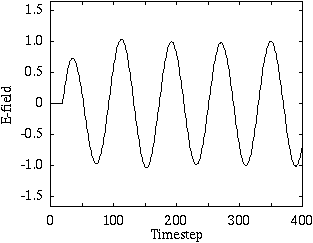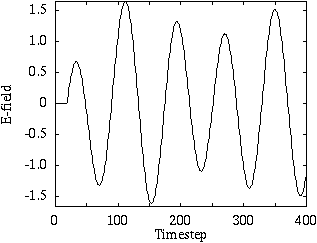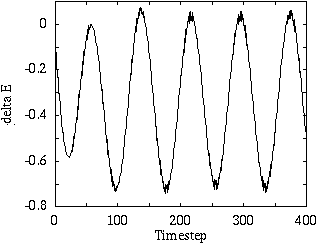Jonathan Herring and Wolfgang J.R. Hoefer
In TLM, voltage pulses are introduced into the system and the time evolution of the fields is observed at appropriate output points. An impulse excitation can be used to obtain information at all frequencies within the working frequency range of the mesh. However, it is often necessary to use a band-limited excitation, for example, to avoid instabilities with certain kinds of absorbing boundary conditions, or to reduce signal processing problems. For such a continuous waveform, the usual approach is to assume that the voltage pulses that must be added to the pre-existing pulses are simply proportional to the desired incident field at each instant in time. In structure such as waveguides, this introduces transients due to the highly dispersive impedance. Alternatively, hard voltage sources may be placed in a reference structure to obtain the correct pulses that must be injected to produce the desired waveform. When these pulses are introduced into the structure under study, the advantages of rapidly decaying transients and absorption of reflected waves are combined.
There is considerable flexibility in the choice of where elements such as sources are introduced, for example, they may be placed at a node or at the mid-point of the link-lines connecting adjacent nodes. Simple circuit theory can be used to place voltage or current sources on the link-lines. Here, sources are placed at a node. Sources can be implemented by substituting a new scattering procedure. Alternatively, the same effect can be achieved by modifying the incident pulses so that the correct scattered pulses are obtained after a standard scattering event. It can be shown that to impose a voltage V_s, a quantity delta_V must be added to the link-lines and stubs contributing to the corresponding electric field component, where
![]()
V_i_tot is the total voltage calculated from the incident pulses. For the hybrid node

Y_a and Y_b are the normalized link-line admittances. Y_s is the normalized open-circuit stub admittance and V_i_1, V_i_2, V_i_3, V_i_4 and V_i_5 are the incident voltage pulses. Similarly, to impose a current, I_s, delta_V is given by
![]()
Z_tot is the combined impedance of the link-lines and stubs. For the hybrid node

The difference between applying a hard voltage source and the conventional additive excitation is shown in fig. 1 for a waveguide structure. The excitation is sinusoidal in time and is applied over the cross-section with the spatial distribution of the dominant mode. In the second case, the amplitude is somewhat indeterminate and steady-state is not achieved quickly. The pulses that are introduced by the hard voltage source are shown in fig. 2. It is apparent that in order to produce a sinusoidal electric field in a waveguide with additive excitation, it would be better to introduce an offset cosine wave rather than a sinusoidal one. A hard source cannot be used directly to obtain S-parameters since it will not absorb the wave reflected from the input port. However, hard sources can be placed in a reference structure and, for each node in the cross-section, the pulses injected by the source can be obtained and then added in to the structure under study. This reference structure need only be a single node thick if Johns matrix boundaries are used. The advantages of this are that a field of known amplitude is introduced in which the transients decay more rapidly than for the conventional approach. This is important for visualization purposes and is essential if the amplitude must be known in advance, for example, when modelling non-linear systems.
(a)  (b)
(b) 
Fig. 1 - Response of a waveguide to the onset of a sinusoidal waveform excitation (a) hard voltage source (b) additive excitation

Fig. 2 - Pulses injected by the source to maintain a sinusoidal waveform
Further details can be found in:
J. L. Herring and W. J. R. Hoefer, "Improved Excitation of 3D SCN TLM Based on Voltage Sources", IEEE Intl. Microwave Symp. Dig., San Francisco, CA USA, June 16-21, 1996.